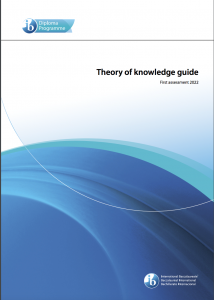This is the first in a series of blog posts that explores the aspects of the new IB TOK syllabus that are most crucial for your planning of the course. These will be pragmatic posts (no lofty pedagogy). They will focus on the stuff in the new Guide that is written between the lines.
Read More:
- For an overview of the new TOK spec, see The new TOK syllabus at a glance.
- How to Download the New TOK Guide
- New TOK Textbook: List of Lessons

Our new blog, textbook, teacher support packs and other resources are here to help you with the new TOK course.
Before I begin, let me say that I don’t mean “traps” and “loopholes” in a negative way, as something that speaks about low quality of the syllabus. Quite on the contrary, it is obvious that the new spec addresses many problems of the old spec, and that a lot of planning and effort has gone into creating a syllabus that would make students’ TOK experiences even more engaging and insightful.
But any syllabus, even the very best one, will have elements that can be misinterpreted and elements that can be used to your advantage.
When I say “traps”, I mean those aspects of the new spec that have a potential to be exaggerated or misunderstood, at least by some teachers. I want to point at such aspects to ensure that you don’t fall into the trap.
When I say “loopholes”, I mean those aspects of the new spec that you can explore to make the course more concise, more focused on assessment or otherwise more suitable to your needs. I want to point at these aspects to ensure that you see these hidden opportunities. To use them or not is up to you.
Here is a brief overview of the blog posts that will be included in this series, for you to know what to expect. As the posts are being written, we will update this page with relevant links.
New aspect of the syllabus |
Trap / loophole |
Link to blog post |
Knowledge framework is now “compulsory”. This means that all four elements of it (Scope, Methods and tools, Perspectives, Ethics) should be taught in all units of the course (themes and areas of knowledge) |
Trap: this could be misinterpreted as a requirement to teach the four elements explicitly. |
Compulsory knowledge framework as a trap: artificial boundaries |
|
Trap: this could be misinterpreted as a requirement to give the four elements equal amounts of time |
Compulsory knowledge framework as a trap: distribution of lesson time | |
|
Loophole: if you organize your course thematically rather than linearly, it will be easy to meet the compulsory knowledge framework requirement without artificial distinctions |
Compulsory knowledge framework as an opportunity: use key concepts and tick all the boxes | |
The course now includes themes (one core and two out of five optional). This gives students a chance to discuss interesting questions not otherwise covered in areas of knowledge, and to find more connections between TOK and real life. |
Trap: TOK essay is based on areas of knowledge. The more time you spend on the themes, the less you prepare students for the essay? |
Themes as a trap: TOK essay is based on areas of knowledge |
|
Trap: The IB strongly recommends to base the TOK exhibition on one of the themes. However, including a link to the theme is not required for the TOK exhibition commentary. |
Themes as a trap: does the TOK exhibition have to be based on one of the themes? | |
|
Loophole: if you teach areas of knowledge through themes, you kill multiple birds with one stone |
Themes as an opportunity: Teaching areas of knowledge through themes | |
The Guide no longer uses the terms “personal knowledge” and “shared knowledge” |
Trap: this distinction is still implicit in the course. Areas of knowledge are about shared knowledge. The core theme (Knowledge and the knower) is about personal knowledge. Optional themes are a mix. Without this distinction, there might be some confusion regarding what is acceptable in the TOK essay and what isn’t. |
Personal and shared knowledge as a trap: Why has the difference been removed? |
|
Loophole: if we return the clear distinction between the two, we can teach themes and areas of knowledge together. |
Personal and shared knowledge as an opportunity: Why we need these terms back when we teach thematically | |
Students are no longer required to formulate their own knowledge questions |
Trap: some teachers may misinterpret this to mean that students don’t have to know the difference between first-order and second-order knowledge and claims. But they do. |
Coming up |
|
Loophole: if you focus the course on teaching key concepts and key thinking skills, students will learn how to answer knowledge questions (not only ask them) |
Coming up | |
|
Loophole: we can restructure the course to model thinking that is necessary in the TOK exhibition and the TOK essay. For this we need to answer our knowledge questions and invite students to argue with us. This is opposed to simply asking a question and inviting students to discuss. |
Coming up |

Alexey Popov is a teacher of IB Psychology and Theory of Knowledge. He is an IB author, examiner and workshop leader. He also authored Oxford IB Psychology books. He currently lives in Hong Kong.
